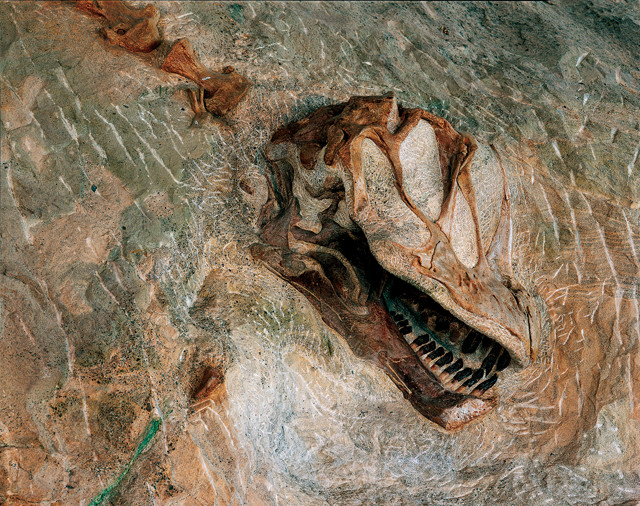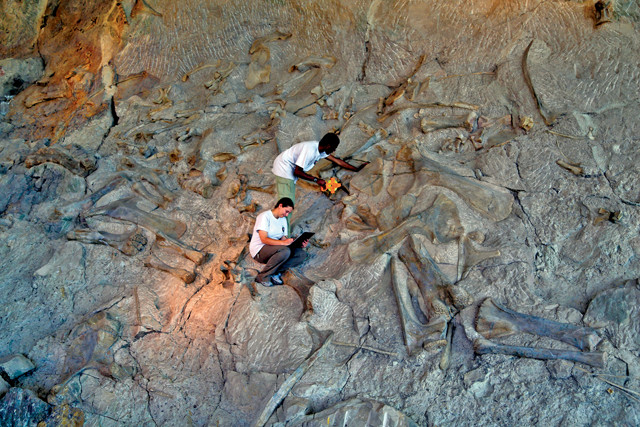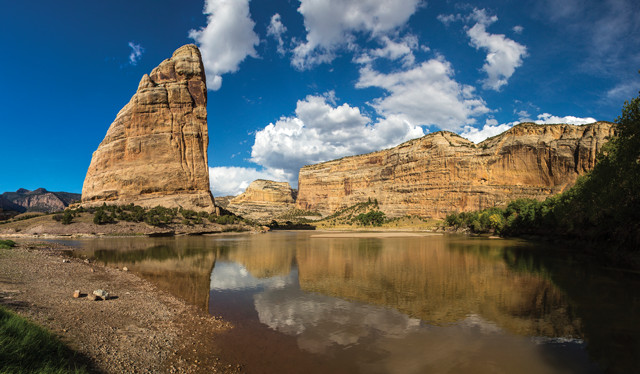
by Lucas Joel Monday, September 21, 2015

The view of Split Mountain at Dinosaur National Monument. Credit: Lucas Joel.
While moving across the country from California to Michigan two years ago, I stopped at Dinosaur National Monument, or “Dinosaur,” which today covers 85,000 hectares and straddles the northern portion of the border between Colorado and Utah. I camped at the Green River Campground on the Utah side, and from there, Split Mountain, on the western margin of the east-west-trending Uinta Mountains, glowed violet-pink in the sunset light.
Near the mountain, about 8 kilometers west of my camp, is where, in 1909, Earl Douglass, a paleontologist from the Carnegie Museum of Natural History in Pittsburgh, discovered dinosaur bones on the land that would become Dinosaur National Monument. These bones, which belonged to a near-complete specimen of the sauropod Apatosaurus, sparked a bone rush: In the ensuing years, excavations at Dinosaur yielded innumerable new dinosaur fossils. To protect the area’s rich natural history, President Woodrow Wilson signed a presidential proclamation designating the region a monument on Oct. 4, 1915.
Douglass was a schoolteacher before he was a paleontologist. He began studying geology and paleontology in his early 30s, and joined the Carnegie Museum in 1902, specializing in mammalian fossils. While collecting and researching early fossil mammals in Montana and Utah on a trip in 1908, Douglass was visited by W.J. Holland, then the director of the Carnegie Museum. In his diary, Holland noted: “One evening, my admiration was excited by a brilliant sunset in which the lofty peaks of the Uinta Range to the northeast loomed up grandly. I remarked to [Douglass] that … in those mountains there were extensive exposures of Jurassic strata, and I said to him that we ought to find the remains of dinosaurs in that region.”
Douglass and Holland hiked into the foothills of the Uintas near Split Mountain and the town of Vernal. The two split up to cover more ground, with Holland telling Douglass to fire his shotgun in the air if he found any bones. Holland later heard Douglass’ shotgun blast, and hurried toward the sound. Weathered out of the rock at the bottom of a narrow ravine was the femur of a Diplodocus, another type of sauropod dinosaur.
This discovery spurred Douglass to return to Utah in July 1909 in search of more dinosaur bones. Not long after setting out along the Duchesne River, southwest of the present-day monument, he received word from Holland, who, being fixated on the previous year’s Diplodocus find, told Douglass to move his search east to “dig up dinosaur bones east of Vernal.”
Douglass returned to where he and Holland had discovered the femur, but found that most of the fossils had already been taken in the interim, writing in his diary on Aug. 12 that he “found dinosaur bones, but nothing good.” A few days later, on Aug. 16, he noted: “The bones were terribly broken up and it seemed as if they had been churned up. Felt rather discouraged.” The next day, though, while searching in a different area, Douglass spotted something: High in an upturned stratum of the Jurassic Morrison Formation, on a saddle between two hills, were eight dinosaur neck bones from an Apatosaurus. “It was a beautiful sight,” he wrote. The vertebrae were still connected, and they seemed to continue unbroken where they disappeared beneath the ground, signaling to Douglass that there might be a complete skeleton underfoot.
Holland, after receiving word about the find, immediately traveled from Pittsburgh to Utah. Excavations began, and, eventually, the team unearthed most of the rest of the skeleton. Holland described the nearly complete skeleton in 1916, naming it Apatosaurus louisae after the wife of Andrew Carnegie, the chief patron of the museum and the dig.

A fossil Camarasaurus preserved in the quarry at Dinosaur National Monument. Credit: National Park Service.
This was the beginning of the “Carnegie Quarry.” Further digging revealed three additional, nearly complete Apatosaurus skeletons beneath Douglass’ first find. The skeletons crosscut one another, and in the middle of the heap was a single sauropod skull. Between 1909 and 1924, the quarry produced almost 320,000 kilograms of dinosaur bones, most of which were shipped back to Pittsburgh, where Douglass’ first Apatosaurus is still on display.
To reach the Carnegie Quarry today, visitors park at Dinosaur’s visitor center and take a tram that snakes up and around the hill that Douglass hiked more than 100 years ago. The scene today, though, is not what it once was. The top of the hill, at the saddle where the Apatosaurus vertebrae were found, has been decapitated; about 15 vertical meters and about 75 horizontal meters of material is gone. What remains of the original excavation is a 60-meter-long, three-story-high wall, exposed on which are approximately 1,500 dinosaur bones. The wall is enclosed by a recently renovated hangar-like building. Visitors can walk up to a viewing platform and see bones from dinosaur species like Allosaurus, Apatosaurus, Camarasaurus, Diplodocus and Stegosaurus.

Interns examining dinosaur bones at the Dinosaur National Monument quarry. Credit: National Park Service.
Douglass, in some of his diary entries, noted that the richness of the quarry’s fossil bone beds made them worth preserving in place. Holland, fortunately, had colleagues at both the U.S. Geological Survey and the Smithsonian who had connections to members of Woodrow Wilson’s administration to whom they pleaded the case for preservation. And, on Oct. 4, 1915, Wilson signed a proclamation declaring 32 hectares surrounding the Carnegie Quarry a monument. Although quarrying did not stop until 1924, establishing the area as a monument prevented others from staking a mineral claim on the land, which might have forced the Carnegie Museum to abandon excavations.
In 1938, President Franklin D. Roosevelt expanded the borders of Dinosaur by 81,000 hectares, which extended Dinosaur’s reach across state lines into Colorado. The expansion incorporated long stretches of the Green River and the Yampa River into the monument. These rivers have helped sculpt Dinosaur’s landscape, exposing bone beds like those at the quarry, as well as cliff surfaces upon which Native Americans etched petroglyphs.
Now, 100 years after its founding, Dinosaur’s chief paleontologist, Daniel Chure, says the monument’s future lies in preservation, not excavation. “We’re interested in protecting and understanding all the ancient ecosystems that are buried in the rock record here,” Chure says. Dinosaur is a good place for such a mission: Of all the national parks, Dinosaur contains the most complete stratigraphic record. “Work here has been biased toward large dinosaurs, which means that a number of small vertebrate fossils, including frogs, salamanders, mammals and lizards have all been overlooked, and we’re working to change that.”
Traditionally, fossil bones are excavated and put on display in museums. But the quarry and the rest of Dinosaur, Chure says, represent an unusual educational and research opportunity: Instead of the fossils being taken to the museum, the museum has been brought to the fossils. This setup provides scientists with information that may otherwise be lost upon excavation, including the position of fossils relative to one another and within the original rock.

Steamboat Rock lies below the confluence of the Green and Yampa rivers at Echo Park. Credit: National Park Service/Jacob W. Frank.
“nbsp; "”
“At Dinosaur, we provide scientists with three unique kinds of data: the bones that have been prepared and which are in our collections and on display in museums; the bones preserved in the quarry face; and the undisturbed, fossil-bearing rock that rests just outside the quarry building,” Chure says. “There are also many fossil sites that occur outside the quarry,” he says, including an area “the size of a few football fields that preserves a great number of dinosaur footprints,” which he and others are working to photograph, cast and mold.
Although open to both researchers and the public, Dinosaur National Monument’s out-of-the-way location limits accessibility to its trove of scientific resources, which includes “about 8,000 photos, diary entries, and other archives,” Chure says. Today, Chure and other park service workers, along with collaborating institutions like Brigham Young University, are digitizing the monument’s collections. The plan within the next two years or so, Chure says, is to upload all archival and scanned data associated with the quarry wall to the Internet, and then to incorporate data from specimens held at other institutions, such as at the Carnegie Museum. “We want to make Dinosaur’s specimens and historic documents accessible to you in your living room.”
Dinosaur’s archives include historic photographs from when bones were first discovered. “Within a couple days of the initial discovery, we have photos of people coming out here in their Sunday suits with rifles to take a look at the bones,” Chure says. There are also articles from the local newspaper in Vernal, which, although not always a purveyor of scientifically accurate news (it occasionally ran stories with titles like “Found remains of two-brained swamp monster”), nevertheless helped document the birth and growth of the monument.
A visit to the monument today offers more than just fossils, as Dinosaur hosts nonfossil-related activities as well; and there is the fantastic landscape, which, on its own, is worth a visit. When I stayed there two years ago, I attended a stargazing event hosted by a park ranger. As I drove north from the Green River Campground toward Split Mountain, tall trees along the river swished heavily and the mountain still glowed in shades of violet, and the sky was clear and bright. Earl Douglass’ comment from more than 100 years ago that Dinosaur is “a beautiful site” certainly applies to more than just bones.
© 2008-2021. All rights reserved. Any copying, redistribution or retransmission of any of the contents of this service without the expressed written permission of the American Geosciences Institute is expressly prohibited. Click here for all copyright requests.